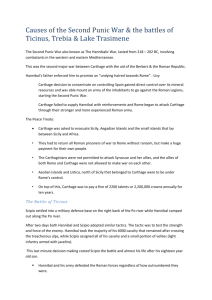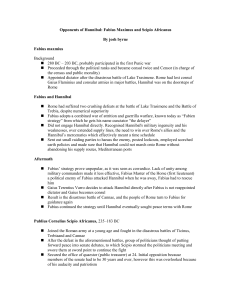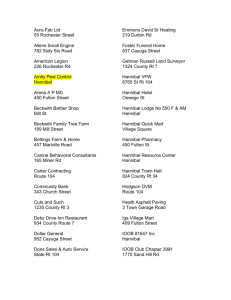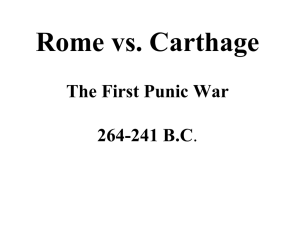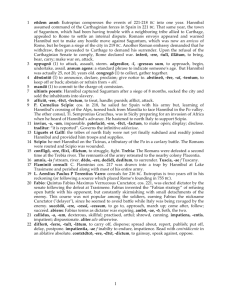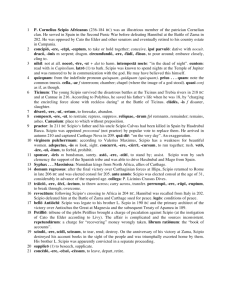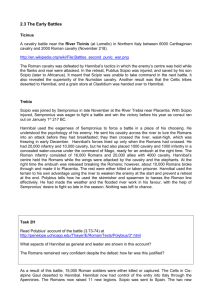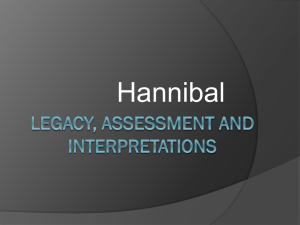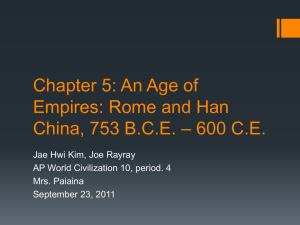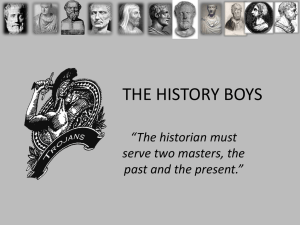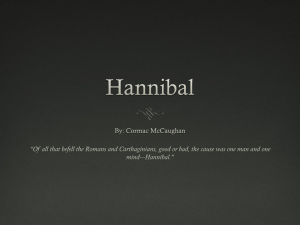Jake Brennan
advertisement
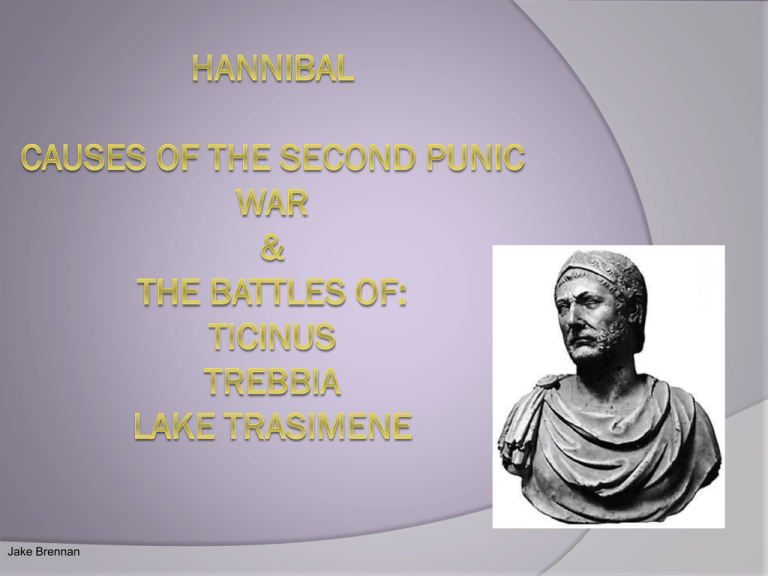
Jake Brennan Causes of the Second War The books of Polybius tell us that there were a number of reasons the second Punic War began: The outcomes of the first Punic War, - The loss of the islands of Sicily and Sardinia - The huge repayment they had to make to Rome Hannibal’s conquest of Spain, the sacking of Saguntum (a Roman ally) Hannibal’s hatred of Rome, his promise to his father as a boy to “Never be a friend to Rome...” Ticinus 218 BC Took place somewhere on the Ticino River, the precise location is not known, a settlement known today as Vigevano is mentioned in the text of Livy The first battle of the Punic war on Italian soil Livy and Polybius both give accounts of the battle, which agree on the main events, but differ in some of the details Both Hannibal and Scipio send out their cavalry army to test the strength of the opponents, but Scipio also sent out a number of velites (light infantry armed with javelins) Hannibal won the battle by seeing the Roman infantry beginning to form, and ordered an immediate all-out charge The Roman infantry fled through the ranks,the Numidian encircled the Roman force, breaking them into groups Scipio was severely wounded and surrounded, Polybius accounts that his 18 year old son, the future Scipio Africanus charged in with some cavalry and escorted him off the battle field Scipio retreated his army back across the river, preventing the Carthaginians from crossing the bridge The Gallic allies in the Roman camp attacked the Romans closest to them sleeping in their tents, took the heads of the slain and crossed to the Carthaginian camp, where they were well received by Hannibal He sent them to gather all the Celts Italy and bring them to join forces with him Scipio once again retreated to the hills on the far bank of the Trebia river, fortifying his defences and deciding to wait for the arrival of the second consul army Battle of Trebia It was the first major battle of the Second Punic War Tiberius Sempronius Longus the consul of the second army, wanted to attack Hannibal out right seeing no reason to wait for more reinforcements Livy states that, Sempronius says to Scipio: "What good is there in further delay and waste of time? Where is the third consul and the third army we are waiting for? ... it is from their native soil, from the land in which they were born, that the Romans are to be driven." He accuses the Romans of "cowering within their camp in the heart of Italy.“ Scipio advised Sempronius to let matters remain as they were, but Sempronius decided to ignore Scipio and go ahead with the attack Hannibal was aware of Sempronius’s eagerness to battle and prepared to use that against him Polybius says: “He had long ago noticed a place between the two camps, flat indeed and treeless, but well adapted for an ambuscade, as it was traversed by a water-course with steep banks, densely overgrown with brambles and other thorny plants, and here he proposed to lay a stratagem to surprise the enemy.” He sent a detachment of 1000 cavalry and 1000 infantry under the command of his younger brother Mago, to conceal themselves in the underbrush to the south of the flat He then sent his Numidian army to harass the Roman camp and retreat hoping for Sempronius to follow Sempronius did exactly what Hannibal was expecting and sent out his consul army and a section of Scipio’s consul Hannibal once again used his encirclement tactic, forcing the Roman cavalry wings back and trapping the infantry men in the centre Seeing that the Roman rear had passed their position, Mago’s hidden force emerged from the ambush and fell upon the rear of the hard-pressed Roman infantry completing the circle The Romans on the sides and in the rear broke formation under this fresh onslaught and ran for the river, Hannibal saw the Roman men trapped by the river and used the opportunity to effect a massacre. Polybius states that many of the Roman soldiers were slaughtered by the river and a number drowned The Roman infantry left in the middle formed a hollow box formation with all sides facing outwards keeping the Carthaginian army back The hollow was where the command post was and where the wounded were placed, allowing for a place for Sempronius to order from Sempronius ordered his men to move forward fighting their way through the Carthaginian centre They successfully made it through the ranks and retreated to Placentia over the river Lake Trasimene It is considered by modern historians as, “one of the largest and most successful ambushes in military history” Gnaeus Servilius Geminus and Gaius Flaminius elected new consuls, to take over the armies of Scipio and Sempronius Four new legions were raised to renumber the armies after their losses at Trebia Hannibal tried luring Flaminius into battle by raiding towns in the region, but Flaminius held his army at camp at Arretium Hannibal marched towards Apulia hoping to finally draw Flaminius out, he like Sempronius, was impetuous, overconfident and lacked self-control and was facing increasing political criticism from Rome He marched against Hannibal. He was advised to only use his cavalry to harass Hannibal to bide time till the other consul army arrived and they joined forces, but he was overconfident and ordered the whole consul to march into battle Hannibal heard that Flaminius was pursuing him and once again found the perfect place to ambush the Romans Along the north side of Lake Trasimine, to the north was a series of heavily forested hills In the night, he concealed his heavy infantry, Gallic infantry and cavalry in the forest to wait in ambush Hannibal ordered his men to light campfires on the hills of Tuoro, at a considerable distance, so as to convince the Romans that his forces were further away than they actually were The Roman troops marched eastward right into the area of the ambush Hannibal then sent a small skirmish force to the front of the Roman line to draw them forward Once the end of the Roman column had entered the zone, Hannibal gave the order, trumpets were blown, signalling the attack to begin The Carthaginian forces swept down onto the unsuspecting Roman forces from the hill side forcing them against the lake and attacking them on three sides The cavalry quickly suppressed the rear of the column preventing any retreat for the Romans In less than four hours, the Roman army was annihilated, of the 30,000 soldiers under Flaminius’s command 15,000 were killed, 10,000 escaped and roughly 6,000 were captured and sold into slavery
